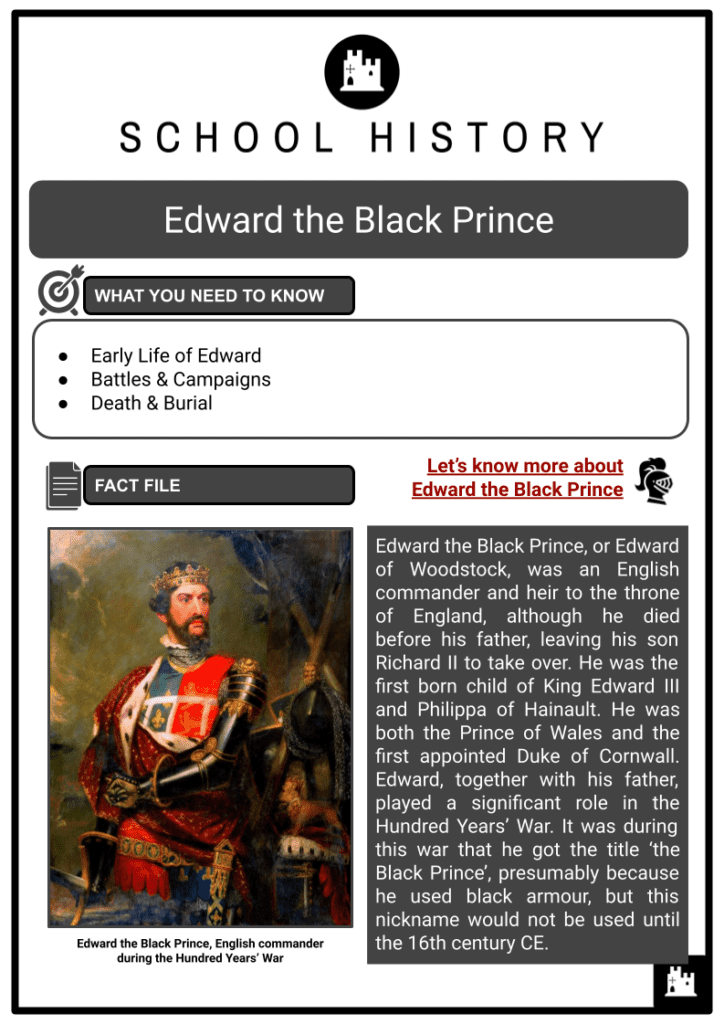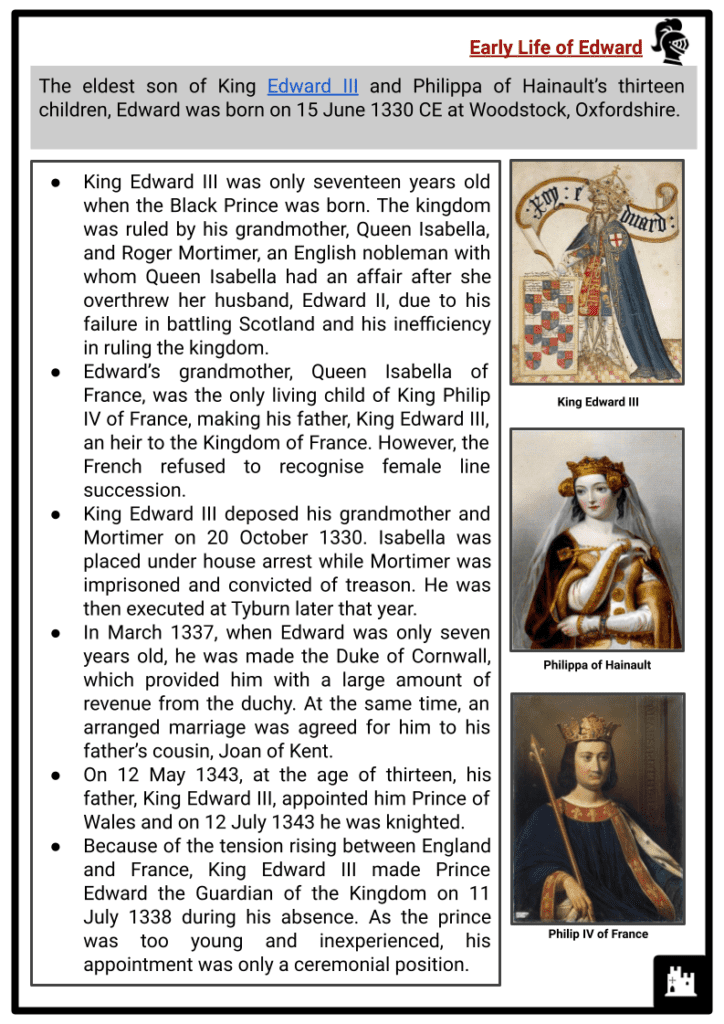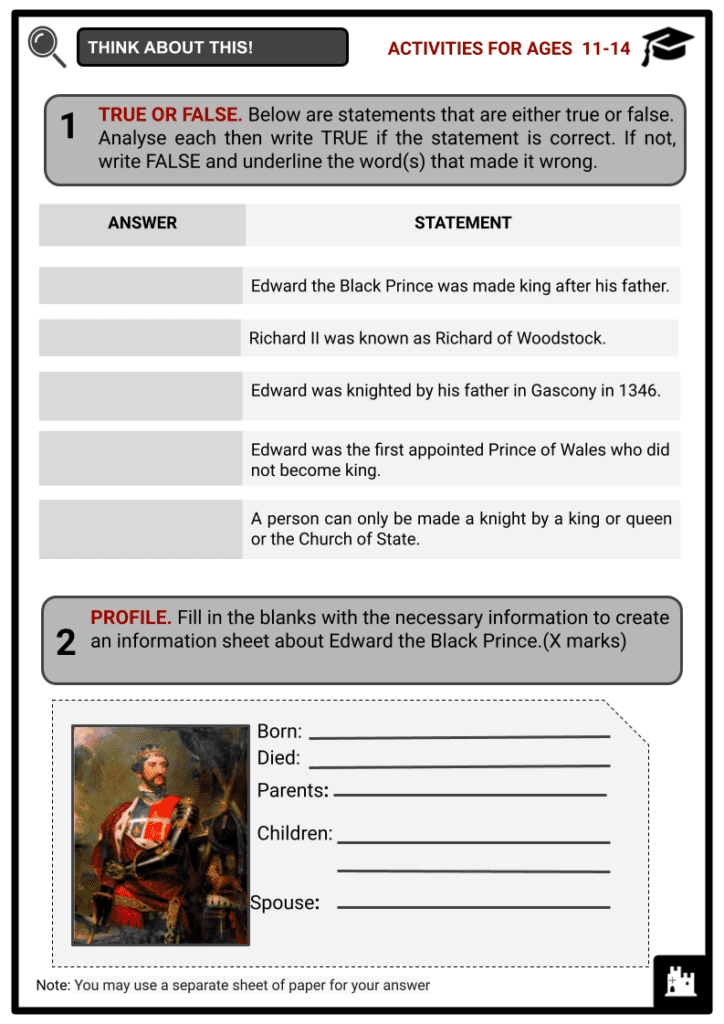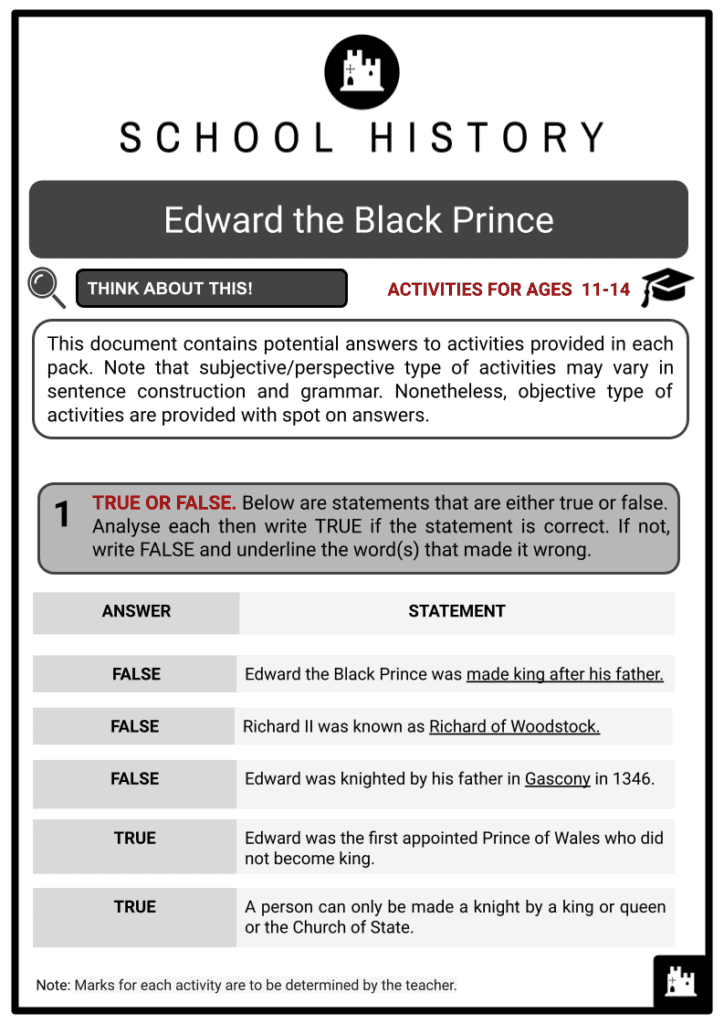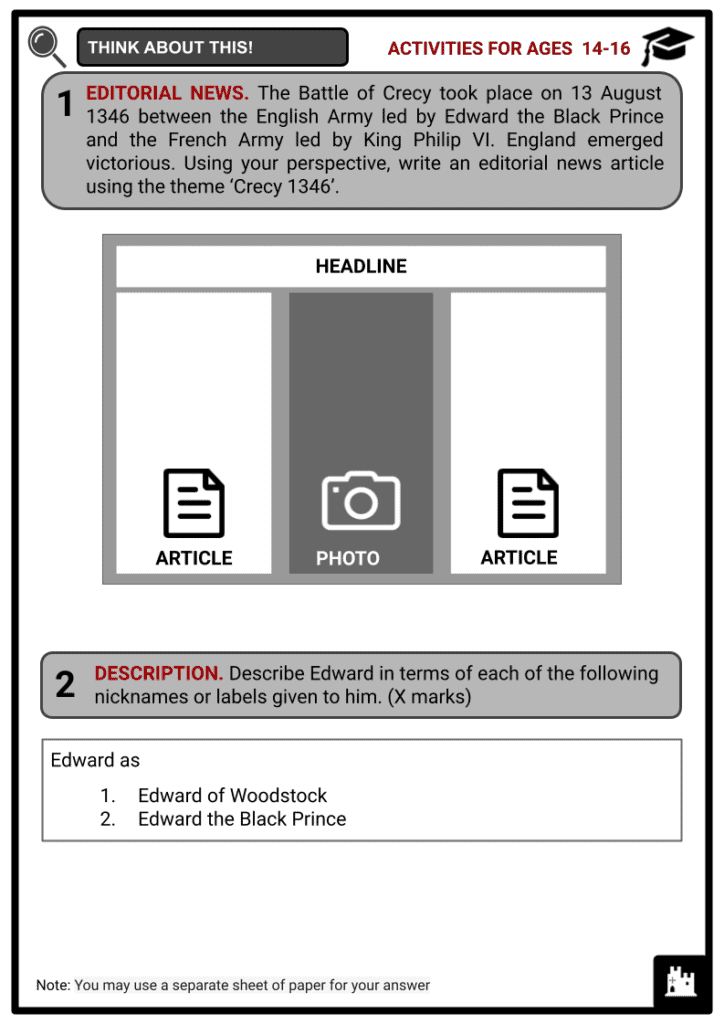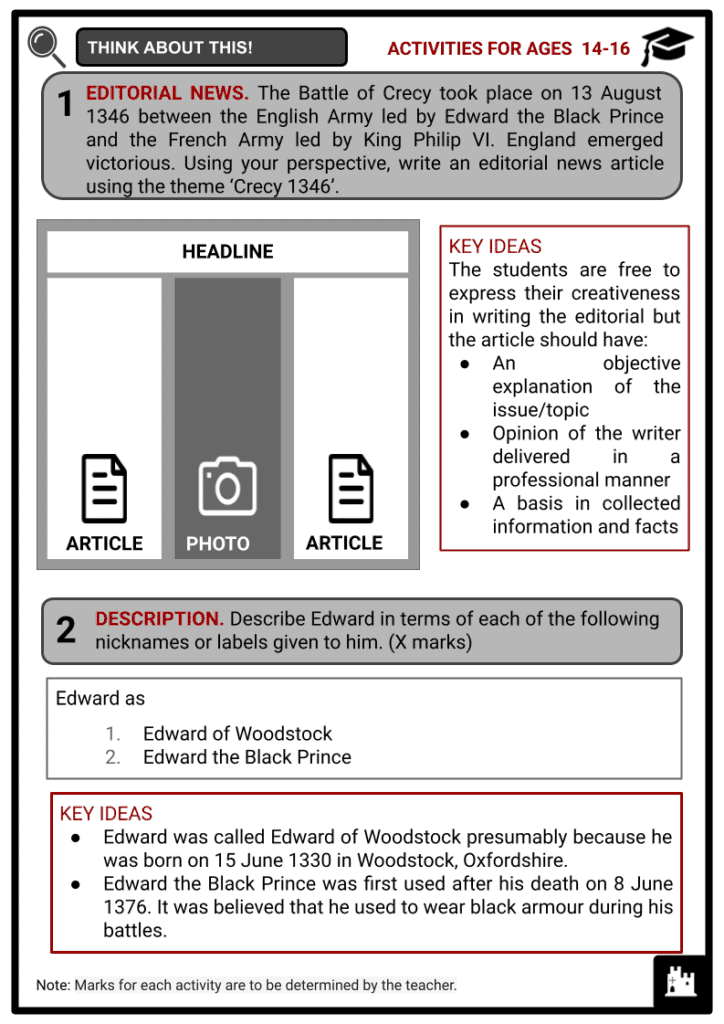Edward the Black Prince Worksheets
Do you want to save dozens of hours in time? Get your evenings and weekends back? Be able to teach about Edward the Black Prince to your students?
Our worksheet bundle includes a fact file and printable worksheets and student activities. Perfect for both the classroom and homeschooling!
Summary
- Early Life of Edward
- Battles & Campaigns
- Death & Burial
Key Facts And Information
Let’s find out more about Edward the Black Prince!
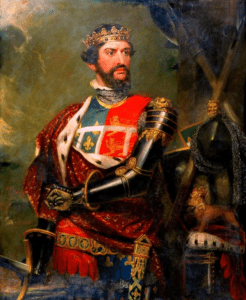
Edward the Black Prince, or Edward of Woodstock, was an English commander and heir to the throne of England, although he died before his father, leaving his son Richard II to take over. He was the firstborn child of King Edward III and Philippa of Hainault. He was the Prince of Wales and the first appointed Duke of Cornwall. Edward, together with his father, played a significant role in the Hundred Years’ War. It was during this war that he got the title ‘the Black Prince’, presumably because he used black armour, but this nickname would not be used until the 16th century CE.
Early Life of Edward
- The eldest son of King Edward III and Philippa of Hainault’s thirteen children, Edward was born on 15 June 1330 CE at Woodstock, Oxfordshire.
- King Edward III was only seventeen years old when the Black Prince was born. The kingdom was ruled by his grandmother, Queen Isabella, and Roger Mortimer, an English nobleman with whom Queen Isabella had an affair after she overthrew her husband, Edward II, due to his failure in battling Scotland and his inefficiency in ruling the kingdom.
- Edward’s grandmother, Queen Isabella of France, was the only living child of King Philip IV of France, making his father, King Edward III, an heir to the Kingdom of France. However, the French refused to recognise female line succession.
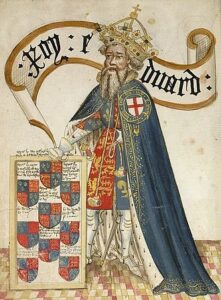
King Edward III - King Edward III deposed his grandmother and Mortimer on 20 October 1330. Isabella was placed under house arrest while Mortimer was imprisoned and convicted of treason. He was then executed at Tyburn later that year.
- In March 1337, when Edward was only seven years old, he was made the Duke of Cornwall, which provided him with a large amount of revenue from the duchy. At the same time, an arranged marriage was agreed for him to his father’s cousin, Joan of Kent.
- On 12 May 1343, at the age of thirteen, his father, King Edward III, appointed him Prince of Wales and on 12 July 1343 he was knighted.
- Because of the tension rising between England and France, King Edward III made Prince Edward the Guardian of the Kingdom on 11 July 1338 during his absence. As the prince was too young and inexperienced, his appointment was only a ceremonial position.
Battles and Campaigns
- Charles IV, King of France, died and left the French throne without any heir, and conflict rose afterwards about who would assume the throne. His mother, Isabella, attempted to claim the throne on behalf of Edward III, but the French refused to acknowledge female line succession. Edward III pursued his more powerful claim to the throne when King Philip VI, the next king of France, started his war campaign by capturing an England-held territory in France, thus starting the Hundred Years’ Wars.
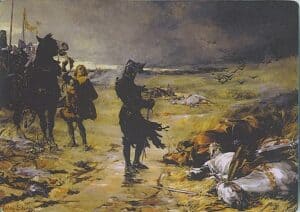
The Black Prince at Crécy by Julian Russell Story, 1888 - On 11 July 1346, Edward and his father started an invasion in Normandy, in which they emerged victorious. With an overwhelming force of more than 15,000 troops, it was a one-sided war. They then marched into France after taking the capital city of Normandy, Caen.
- On 26 August 1346, the Battle of Crecy took place. This time, the French army was facing Edward and his men with a much larger force, which included the Genoese crossbowmen. But the English army retaliated and later on gained the upper hand in a battle with their weapon, the longbow. And on 4 September 1346, the French town of Calais was besieged. It was the same year that Edward’s brother, Thomas, was born but died before he turned a year old. On 12 October 1347, Edward of Woodstock returned to England. He participated in the jousts arranged to commemorate the win of the victorious English army, which earned him and the twenty-four other knights the Order of the Garter, a knighthood founded by his father.
- In 1348, during the Black Death, a bubonic plague pandemic occurred. It reached England and brought about the death of almost one-third of its population. Because there were not enough workers to keep food and other product production going, the economy suffered a disastrous consequence. In the same year, Edward’s brother William was born at Windsor Castle but faced the same fate as his late brother, Thomas. He died before September 1348.
- On 22 August 1350, King Philip VI died and his son John assumed the throne. Later on that year, the battle of Winchelsea took place. The Black Prince, together with his younger brother John of Gaunt, emerged victorious against Charles de la Cerda of Spain.
- On 10 July 1355, Edward was designated Lieutenant by his father, King Edward III, in Gascony. This position gave him the capacity to make decisions in the king’s name. In the same year he set off from Plymouth with a huge army and a fleet of ships towards Gascony. Later, in the autumn of 1355, the Black Prince started his multiple assaults against Aquitaine.
- On 19 September 1356, after succeeding his father, the Battle of Poitiers occurred with King John as the new King of France and the English army led by the Black Prince.
- Edward was successful in taking victory over the much larger forces of France by using the same tactics that he used during the Battle of Crecy. King John, together with his son Philip, was held captive.
- On 10 October 1361, Edward the Black Prince married Joan of Kent, with whom he had an arranged marriage when he was only seven years old. They went to Gascony and resided. Together they had two children, Edward of Angouleme, who died on 20 September 1370, and Richard II, who later on took the crown.
- On 27 January 1365, King John II of France died, and his son Charles V assumed the throne.
- The downfall of England and Edward started to emerge after several defeats and troubles against the French kingdom. On 3 April 1367, the Battle of Najera took place between Peter of Castile and Henry of Trastamara with Edward in support of Peter. It was a loss for Edward and Peter as the new king of France, King Charles V, intervened and aided Henry of Trastamara. Peter of Castile was later on killed and Edward absorbed a huge amount of debt and casualties.
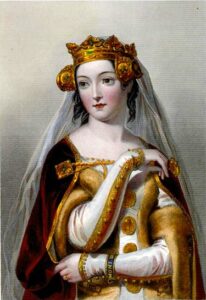
Philippa of Hainault - On 15 August 1369, Edward’s mother, Philippa of Hainault, died. In August 1370, the town of Limoges, Aquitaine conceded to the French. This made Edward furious and on 19 September 1370 he ordered an attack in Limoges where around 3,000 people were killed. This was the same year his eldest son, Edward of Angouleme, died.
Death & Burial
- During the year 1370, while Edward was at war with France, he became infected with dysentery, a very contagious sickness that involves diarrhoea with mucus or blood.
- In January 1371, the Black Prince was not recovering from his illness and decided to return to England. He gave up his title as the Prince of Aquitaine and Gascony due to the losses he incurred during the battles.
- During the year 1375, the Treaty of Bruges was signed. This agreement limited England’s territory in France to Bayonne, Calais and Bordeaux. In the spring of 1376, the Black Prince became ill again due to dysentery and a suspected war wound.
- On 8 June 1376, Edward the Black Prince died at the Palace of Westminster. During his last days, he was often accompanied by the Bishop of Bangor, who told him to repent from his sins during his war campaign which primarily composed of all the people he killed.
- He was buried in Canterbury Cathedral. Shortly after, his only living son, Richard II, took the throne. Together with his tomb lies a French poem:
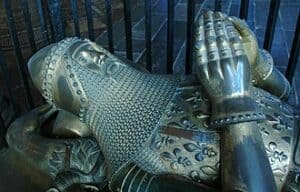
Effigy of Edward the Black Prince, Canterbury Cathedral, 1376
Such as thou art, sometime was I.
Such as I am, such shalt thou be.
I thought little on th'our of Death
So long as I enjoyed breath.
On earth I had great riches
Land, houses, great treasure, horses, money and gold.
But now a wretched captive am I,
Deep in the ground, lo here I lie.
My beauty great, is all quite gone,
My flesh is wasted to the bone.
- Though Edward the Black Prince never ascended the throne, he was remembered as one of the greatest knights and military commanders in history, achieving back and forth victories during the Hundred Years’ Wars against its rival, France. He was also the first appointed Prince of Wales who did not become king.
- Despite being outnumbered by the enemy, France, Edward managed to pull off victories in most of his wars, including the most famous Battle of Crecy and Battle of Poitiers, where the legend of the Black Prince first started.
- Shortly after his death on 8 June 1376, his son Richard II took the crown and was coronated on 16 July 1377. He was known as Richard of Bordeaux. His reign lasted for 22 years as he was overthrown by Henry Bolingbroke (Henry IV) in 1399. Henry was the son of John the Gaunt, the third son of King Edward III and Philippa of Hainault, and the brother of Edward the Black Prince. Richard II faced several predicaments during his time, most significantly the Peasants’ Revolt, which occurred in 1381. A result of the government’s weak response during the Black Death epidemic and the economical crisis caused by the Hundred Years’ War led to a collection of higher taxes. He died at the age of 33 on 14 February 1400 at Pontefract Castle, Yorkshire.
Did you know?
During the Middle Ages, knights played a significant role in wars and the monarchy. They were equipped with heavy armoury and were known to ride horses. They were also given special military ranks. A person could only be made a knight by a king or queen or the Church of State. Edward the Black Prince was knighted by his father, King Edward III, in La Hogue in 1346.
Image Sources
- https://upload.wikimedia.org/wikipedia/commons/thumb/f/f9/Edward_the_Black_Prince.webp/738px-Edward_the_Black_Prince.webp.png?20220214112412
- https://upload.wikimedia.org/wikipedia/commons/thumb/d/de/Edward_III_of_England_%28Order_of_the_Garter%29.jpg/330px-Edward_III_of_England_%28Order_of_the_Garter%29.jpg
- https://upload.wikimedia.org/wikipedia/commons/thumb/2/22/Philippa_of_Hainault%2C_Queen_consort_of_England.jpg/375px-Philippa_of_Hainault%2C_Queen_consort_of_England.jpg
- https://upload.wikimedia.org/wikipedia/commons/thumb/7/70/The_Black_Prince_of_Crecy.jpg/495px-The_Black_Prince_of_Crecy.jpg
- https://upload.wikimedia.org/wikipedia/commons/thumb/0/0f/TombaPrincepNegre.JPG/330px-TombaPrincepNegre.JPG

